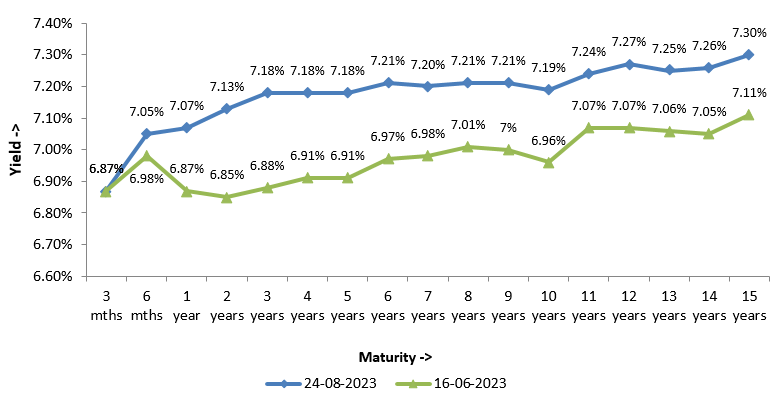Why invest in target maturity funds in this interest rate environment?

Passive investing in India
Passive investing has taken off in a big way in India since the outbreak of the COVID-19 pandemic. As per AMFI data, in the last four years ending 31st July, 2023, passive assets under management (AUM) grew by nearly five times (5X) at a compounded annual growth rate (CAGR) of nearly 49% (source: AMFI July 2023 data). Passive AUM stood at nearly Rs 7.7 lakh crores as on 31st July 2023. Exchange Traded Funds (ETFs) and Index Funds are the two vehicles for passive investments. Both ETFs and index funds track benchmark indices.
ETFs are listed on stock exchanges and trade like shares of companies. ETFs are more popular with Institutional Investors and HNIs, but there is increasing retail interest in ETFs. You need demat and trading accounts to invest in ETFs. As per AMFI July data, total ETF AUM (including Gold ETF) was Rs 5.7 lakh crores (nearly 75% of total passive AUM). Index funds, on the other hand, are open ended mutual fund schemes. Total index funds AUM as on 31st July 2023 stood at Rs 1.8 lakh crores (source: AMFI, 31st July 2023). Index funds are suitable passive investment options for retail investors who do not have demat accounts.
Passive investing in debt
Most investors associate passive investing with equity and commodities (e.g. gold) asset classes. However, some of you may be surprised to know that passive debt AUM (both regular and direct) is nearly 40% of total passive AUM (source: Advisorkhoj ETF Corner, Advisorkhoj Index Fund Corner) as on 31st July 2023. There are more than 100 passive debt products (both ETFs and Index Funds). Passive investing in debt is relatively new, and a large share of AUM belongs to institutional investors and corporates. However, over the past year or so, there has been growing retail interest in passive debt products, especially Target Maturity Funds. Target Maturity Fund AUM (both direct and regular) is more 90% of passive debt AUM.
What are Target Maturity Funds?
Target maturity funds are open ended passive debt mutual fund schemes, which track an underlying bond index and have defined maturity dates. You will get the principal along with accrued interest on maturity of the fund. Target maturity funds can be in the form of Exchange Traded Funds (ETFs) or Index Fund. You need demat and trading accounts to invest in ETFs. If you do not have Demat account then, you can invest in Target Maturity Index Funds.
How Target Maturity Funds work?
- As per SEBI’s regulations, Target Maturity Funds can invest only in Government Securities (G-Secs), State Development Loans (SDLs) and Public Sector Undertaking (PSU bonds).
- Target Maturity Funds track an underlying bond index. These underlying bond indices have a basket of bonds with a pre-defined maturity date.
- A target maturity fund will invest in exactly the same basket of bonds as the underlying index and hold them till maturity.
- The bonds will pay regular coupons (interest), which are re-invested in the same basket of bonds. On maturity you will get the face value of the bonds (principal amount) and the accrued interest.
- Since target maturity funds hold bonds till maturity, you can lock in current yields by holding the fund till maturity date.
Current interest rate environment
Global bond yields have been inching up over the past 2 months or so after higher US Treasury Bond issuance after resolution of the US debt ceiling crisis. Bond yields in India also crept up in the last 2 months by 20 – 30 bps across the 3 to 10-year maturities in the Government Bond yield curve (see the chart below). This provides an excellent investment opportunity for long-term investors, if you want to lock in these yields over your investment tenure by investing in target maturity funds whose maturities match your investment tenure.

Source: Worldgovernmentbonds.com, as on 24th August 2023. Disclaimer: Bond yields depend on market and economic conditions and can change in the future. The chart above is purely for investor education purposes and should not construed as investment recommendations.
Interest rate outlook and bond yields
The market is expecting Reserve Bank of India (RBI) to hold interest rates till the end of this year (no rate hike) and then rate cuts in 2024. Bond yields are slowly following the US bond yields and, at the same time, are also closely following RBI’s repo rate policy. The US market expects one more Fed rate hike in September and then a pause. Accordingly, we believe bond yields are near their peak and may come down in the coming months, though we may see an occasional blip. This may be a suitable interest environment to invest in target maturity funds. You should invest according to your risk appetite and consult your financial advisor or mutual fund distributor if required.
Why invest in Target Maturity Funds?
- Target Maturity Funds provide high visibility of returns i.e. yield to maturity (YTM) if you hold till maturity of the fund, adjusted for Total Expense Ratio (TER).
- Yields of G-Secs across different maturities in the current yield curve are higher than interest rates of traditional fixed income products e.g. Bank Fixed Deposits (FDs), Post Office (PO) small savings schemes. Target maturity funds also invest in SDLs and PSU bonds, which give higher yields than G-Secs.
- The TERs of Target Maturity Funds are lower than TERs of actively managed funds.
- Since target maturity funds hold bonds till maturity, the duration of the scheme will reduce over the passage of time. For example, if you buy a 5-year bond this year, next year, the same bond will become a 4-year bond. The duration of a bond is directly related to interest rate risk. Since duration reduces as the maturity approaches, the interest rate risk will also reduce over the investment tenure.
- According to the current interest rate outlook, rates have peaked and may come down in 2024. If interest rates come down, you may get capital appreciation (bond prices and fund NAVs will go up if interest rates come down). However, we believe the primary investment objective in debt funds should be income and not capital appreciation.
- The credit quality of Target Maturity Funds is very high. G-Secs have sovereign guarantees. SDLs are State Government bonds; interest and principal payments of SDLs are guaranteed by the RBI - no credit risk. PSU bonds enjoy quasi-sovereign status since they are owned by the Government.
Investors should consult with their financial advisors or mutual fund distributors if target maturity funds suit their fixed-income investment needs.
Mutual Fund Investments are subject to market risk, read all scheme related documents carefully.
RECOMMENDED READS
The information being provided under this section 'Investor Education' is for the sole purpose of creating awareness about Mutual Funds and for their understanding, in general. The views being expressed only constitute opinions and therefore cannot be considered as guidelines, recommendations or as a professional guide for the readers. Before making any investments, the readers are advised to seek independent professional advice, verify the contents in order to arrive at an informed investment decision.
Mutual Fund investments are subject to market risks, read all scheme related documents carefully.
Quick Links
Follow Nippon India MF
More About Nippon India MF
POST A QUERY






